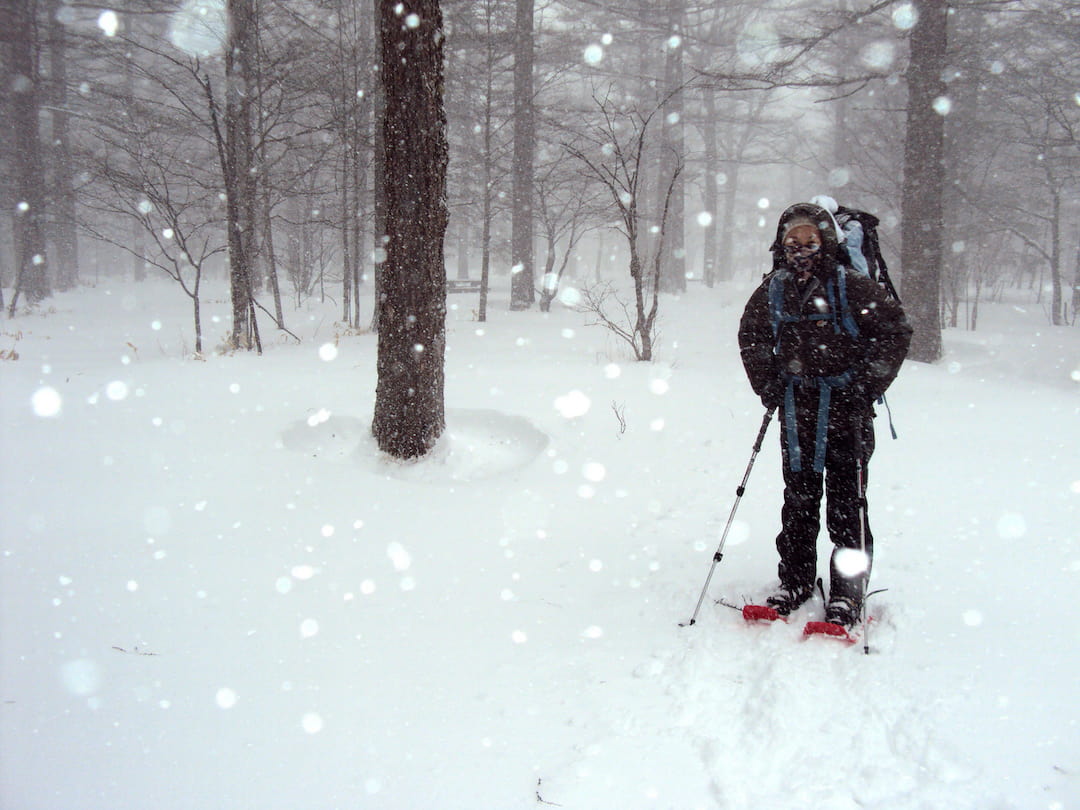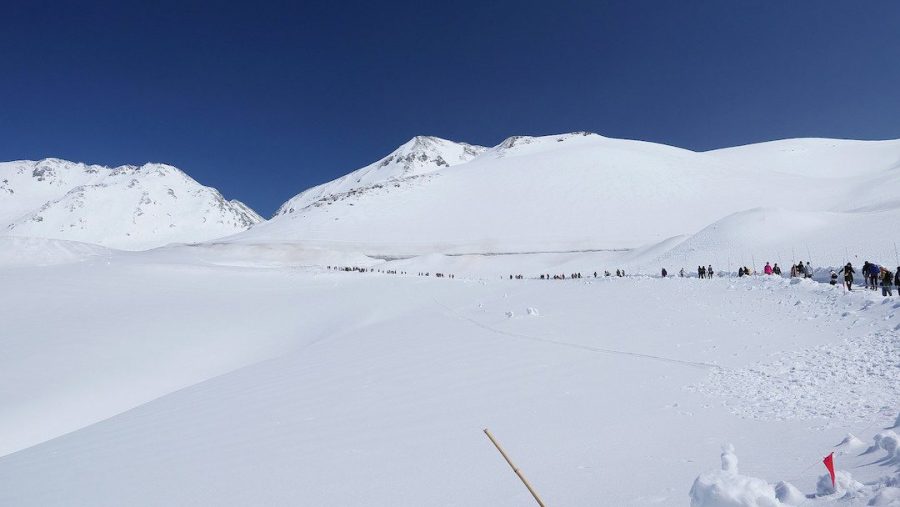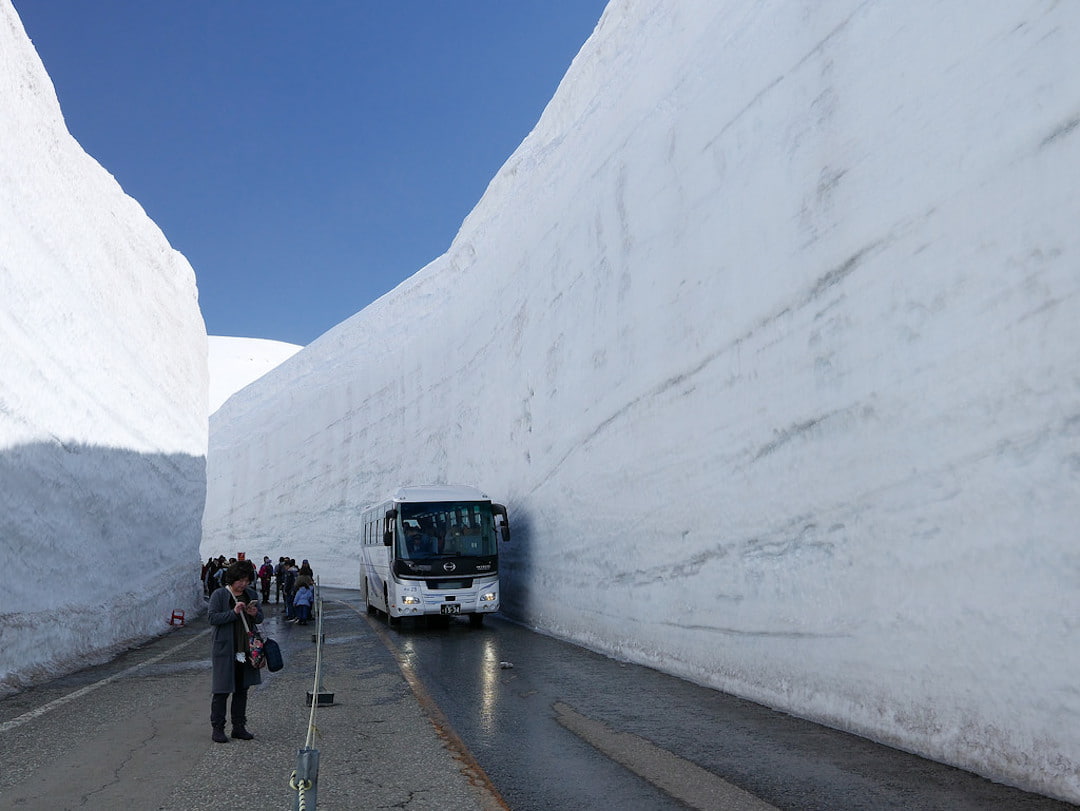Towering peaks up to 3,000 metres tall stand tall in the heart of Japan’s Honshu island, dividing the area into two parts. These are the Japanese Alps, encompassing four prefectures and three of the country’s mightiest mountain ranges – the Hidas, Kiso, and Akaishi.
In warmer months, they’re sun-dappled and covered with carpets of green, where absurdly beautiful valleys and picturesque towns sit peacefully and mighty summits keep a relentless watch nearby.
Yet in the wintertime, they’re even more thunderous, glistening with fresh white snow, wind-chiselled facades that are simply spectacular. Make no mistake: hiking the Japanese Alps in the middle of winter is no easy feat. But every trail, every journey is incredible and the views you will be rewarded with are utterly breathless.
From the best trails to the essential gear, here’s everything you need to know about hiking the Japanese Alps in the winter.

What you need to pack
Any winter hike in the mountains comes with an element of preparation that you won’t typically need on a regular hike. After all, winter hikes are more involved on account of the weather, temperature, wind conditions, and even the conditions of the trails.
Most importantly, make sure you have all the gear you need to stay warm, protect yourself from any harsh weather you might encounter, and even keep yourself safe.
Here are some of the essential winter hiking wear and equipment you need to tick off your list:
- A set of trekking poles to help with your balance and reduce strain on your lower extremities
- Snowshoes which you can rent from a ski shop
- Winter boots that are comfortable, insulated and waterproof
- Toe and hand warmers that last for hours
- Top and bottom base layers made of breathable wool to keep warm and dry
- A fleece vest or jacket
- A light waterproof jacket
- A raincoat
- A gaiter to protect your face and keep your neck warm
- A beanie to keep your head warm
- A pair of warm gloves with leashes
- At least two pairs of wool ski socks (in case one gets wet)
- Sunglasses or ski goggles, as the snow can be blinding
Best trails for winter hikes in the Japan Alps
The Japanese Alps are a tellurian paradise for trekkers, backpackers, and day hikers, thanks to the intricate and diverse network of trails and footpaths. Whether you’re looking for day hikes to transformative hikes, these mountains are the perfect setting for riotous adventures with its amazing trails that travel past captivating landscapes and spill into mountain retreats or epic panoramas.
Kamikochi
Nestled in the heart of the Chubu Sangaku National Park is the alpine valley of Kamikochi, known best as an excellent starting point for wild and woolly adventures on the trail.
Hiking trails in Kamikochi range from easy, two-hour walks to challenging hikes. A scenic, the 3.5-kilometre walk may be had from the Kappa Bridge along the Taisho Pond path. You can also jump on a cable car up to the Nishi Minoru mountain hut and take the trail up to the Nishihotaka and Doppyo Peaks. Or hike up, beneath the peaks of the Hotakas, to the Dakesawa mountain hut for awe-inspiring vantage points.

Hakuba Valley
The Olympic Winter Games of 1998 isn’t Hakuba’s only claim to fame. The mountain range is also known for its hiking trails and beautiful landscape. One popular, 1.5-hour trail takes you from the Hakuba Happo One – accessible by a cable car and a chairlift from Happo Station to Happo Pond where covetable landscape scenes and reflections of several snow-capped peaks must be photographed.
If you’ve got more energy and time, continue along the Happo Ridge to the Karamatsu Peak for even more impressive vistas.
Komagane Kogen
Hike in the clouds near the city of Komagane in the Nagano Prefecture. From the ski resort of Komagane Kogen, take the bus and ropeway to the Senjojiki Cirque, a depression formed from an eroded glacier. The cirque is home to a trailhead that ascends to the ridgeline between the peaks of Hokendake and Nakadake, and offers a sweeping panorama of the Central Alps. Your terminus ad quem, however, is the top of the Kisokomagatake, the highest in this section of the Japanese Alps where edelweiss are known to make an appearance. Another trail worthy of carving out time for? The hike along and across the Azusa River to the serene Myo-jin Pond.
Nakasendo Road
A favourite among travellers is the trail that connects the towns of Tsumago and Magome. The beauty of the old, 8-kilometre Nakasendo road is that it takes you on an enchanting hike through a verdant cypress forest where bear sightings are a possibility (so much that they offer bell rentals to warm them that you’re coming).
It’s an easy trek, but for more of an effortless, mostly downhill hike, start from Magome. For a shorter option, there’s also a 6-kilometre village-to-village path from Yabubara to Narai.
Tateyama

Known for the Tateyama Kurobe Alpine Route, the town of Tateyama is another starting point for elevating trail adventures. Take a tram across the mountains to Murodo where you can ascend past the Ichinokoshi Mountain hut, the Shinto shrine on O-yama, and Tateyama’s highest point to Bessan peak then back. Feast your eyes on impressive sights, hot springs, and crater lakes.
While the trails are not accessible during winter, during spring and autumn will still reach icy temperatures where the above packing tips will absolutely apply.

Top tips to keep in mind
Though hiking through the Japanese Alps in the middle of winter might not be the easiest, there are ways to make your hike a pleasurable and safer one, whether you’re exposed to many dangers on a backcountry trail or more sheltered on a touristy paved path.
Here are a few valuable tips to keep in mind:
- Pack enough water and food high in protein to keep you hydrated and fuelled. You’ll be burning a lot of energy not only from hiking but also from keeping your body warm.
- Take some safety equipment such as a shovel or an avalanche beacon.
- Dress warmly, but comfortably. Make sure your extremities are getting enough circulation.
- Record your course at specific points along your hike, especially if you’re up in the high mountains or the backcountry. This way, if you lose your way or something happens, people will have an idea of where to find you.
- Take a bell to ward off bears.
- Be sure to find out if you have the necessary equipment if you’re going on a technical trail.
- Master the kanji characters for navigation, geography, and possibly even the names of important landmarks along your trail. They could help save your life.
Are you ready to hike Japan?

